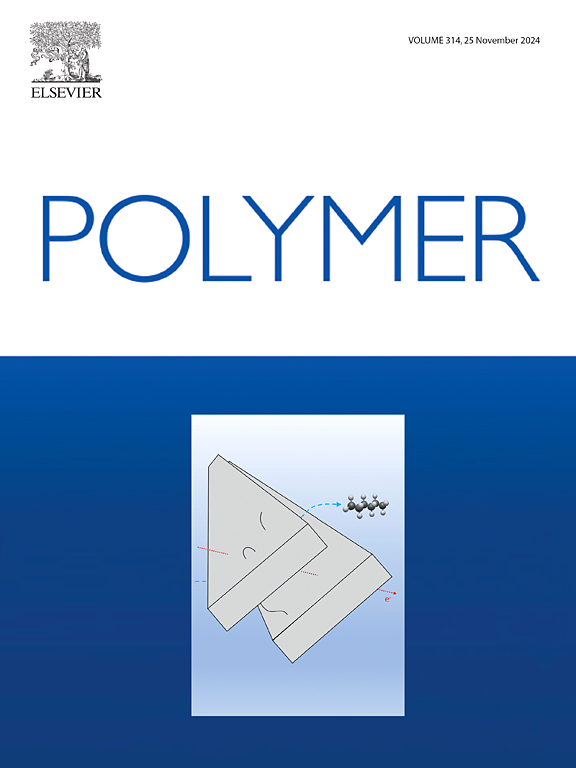Bio-based polymer composites via pickering Emulsions: Xanthated cellulose nanofibers as a dual-function intermediate
IF 4.5
2区 化学
Q2 POLYMER SCIENCE
引用次数: 0
Abstract
The uniform dispersion of nanocellulose in polymer matrices remains a challenge in polymer composite fabrication. In this study, we develop a bio-based, surfactant-free approach to prepare polymer composites using xanthated cellulose nanofibers (XCNF) as a dual-function intermediate. XCNF, derived from a modified viscose rayon process, serves as both an emulsion stabilizer and a precursor to regenerated cellulose nanofibers (RXCNF). By stabilizing oil-in-water (O/W) Pickering emulsions containing poly(lactic acid) (PLA) solution, XCNF enables the formation of PLA microsphere latex structures (∼640 nm diameter) upon drying, ensuring intimate proximity between nanofibers and polymer particles. Energy-dispersive X-ray spectroscopy (EDX) confirmed the spontaneous conversion of XCNF into RXCNF, allowing in-situ formation of a reinforcing nanofiber network without additional chemical modifications. The resulting microsphere latex was used as a masterbatch for melt-mixing with PLA to fabricate PLA/RXCNF composites. Differential scanning calorimetry (DSC) revealed enhanced crystallization, while dynamic mechanical analysis (DMA) confirmed a significant increase in storage modulus, particularly beyond the glass transition temperature, demonstrating the reinforcing effect of RXCNF. Additionally, light transmittance measurements showed a progressive reduction in transparency with increasing RXCNF content due to nanofiber-induced light scattering. This approach leverages XCNF as a functional intermediate, providing a scalable and environmentally friendly strategy for bio-based polymer composites with improved performance. With the increasing industrial interest in RXCNF due to its stability and reinforcing potential, this method aligns well with ongoing efforts to commercialize cellulose-based nanomaterials.


通过Pickering乳剂的生物基聚合物复合材料:黄原纤维素纳米纤维作为双功能中间体
纳米纤维素在聚合物基体中的均匀分散仍然是聚合物复合材料制造中的一个挑战。在这项研究中,我们开发了一种基于生物的,无表面活性剂的方法,以黄原纤维素纳米纤维(XCNF)作为双功能中间体来制备聚合物复合材料。XCNF源自一种改性粘胶工艺,可作为乳液稳定剂和再生纤维素纳米纤维(RXCNF)的前体。通过稳定含有聚乳酸(PLA)溶液的水包油(O/W) Pickering乳状液,XCNF使PLA微球乳胶结构(直径约640 nm)在干燥时形成,确保纳米纤维和聚合物颗粒之间的紧密接近。能量色散x射线光谱(EDX)证实了XCNF自发转化为RXCNF,无需额外的化学修饰即可原位形成增强纳米纤维网络。将所得的微球乳胶作为母粒与PLA熔融混合制备PLA/RXCNF复合材料。差示扫描量热法(DSC)显示了增强的结晶,而动态力学分析(DMA)证实了存储模量的显著增加,特别是在玻璃化转变温度之后,证明了RXCNF的增强作用。此外,透光率测量显示,由于纳米纤维诱导的光散射,随着RXCNF含量的增加,透明度逐渐降低。该方法利用XCNF作为功能性中间体,为生物基聚合物复合材料提供了一种可扩展且环保的策略,并提高了性能。由于RXCNF的稳定性和增强潜力,工业对它的兴趣越来越大,这种方法与正在进行的纤维素基纳米材料商业化的努力是一致的。
本文章由计算机程序翻译,如有差异,请以英文原文为准。
求助全文
约1分钟内获得全文
求助全文
来源期刊

Polymer
化学-高分子科学
CiteScore
7.90
自引率
8.70%
发文量
959
审稿时长
32 days
期刊介绍:
Polymer is an interdisciplinary journal dedicated to publishing innovative and significant advances in Polymer Physics, Chemistry and Technology. We welcome submissions on polymer hybrids, nanocomposites, characterisation and self-assembly. Polymer also publishes work on the technological application of polymers in energy and optoelectronics.
The main scope is covered but not limited to the following core areas:
Polymer Materials
Nanocomposites and hybrid nanomaterials
Polymer blends, films, fibres, networks and porous materials
Physical Characterization
Characterisation, modelling and simulation* of molecular and materials properties in bulk, solution, and thin films
Polymer Engineering
Advanced multiscale processing methods
Polymer Synthesis, Modification and Self-assembly
Including designer polymer architectures, mechanisms and kinetics, and supramolecular polymerization
Technological Applications
Polymers for energy generation and storage
Polymer membranes for separation technology
Polymers for opto- and microelectronics.
 求助内容:
求助内容: 应助结果提醒方式:
应助结果提醒方式:


